Before we delve into this topic, it’s crucial to clarify that this article is not intended as a judgmental critique of those who use specific tools for training. I’ve yet to meet a person who doesn’t deeply care for their dog. Instead, this article aims to provide information about the tools available, empowering those who wish to make informed decisions regarding their dog’s well-being.
With that said, numerous studies and extensive research have unequivocally demonstrated that employing aversive methods in dog training can result in lasting detrimental effects. It’s essential to remember that behavior refers to “the way in which an animal or person acts in response to a particular situation or stimulus.” The term ‘aversive’ is defined as “causing strong dislike or disinclination.” In the context of ‘aversion therapy,’ it refers to “a type of behavior therapy designed to make patients give up an undesirable habit by causing them to associate it with an unpleasant effect.” While some tools may seemingly halt undesirable behavior immediately, research indicates that training with aversive methods is ineffective in altering the emotional underpinnings of that behavior. Now, let’s explore the tools available in the market today.
Collars
Flat/Regular Collar: These collars can be crafted from various materials like Neoprene, polyester, leather, linen blends, and come in varying widths. They are generally not round but can be.

Martingale Collar: A variation of the flat collar, the Martingale features a section that tightens when the dog pulls. This part can be made of chain or the same material as the collar itself.

Prong Collar: This tool encircles a dog’s neck and includes metal spikes (sometimes with rubber nubs on the ends). A chain with a clip tightens when the dog pulls.

E-Collar/Bark Collar/Training Collar: These flat collars incorporate a small box. The side of the box that contacts the dog’s neck features two little prongs that deliver a shock or vibration. Some have sound options, while others use citronella spray that is directed toward the dog’s nose. Some collars automatically activate sound, shock, or vibration in response to the dog’s barking (bark collar), while others have a remote control (training collar) for the human to manage the shock or vibration applied to the dog’s throat. These collars offer different shock and vibration levels and can be paired with invisible fences, where crossing the boundary triggers a shock.
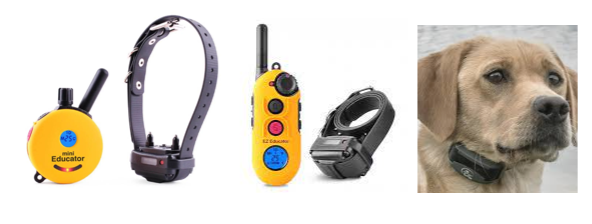
Harnesses
Face Harness/Head Halter/Headcollar: This device comprises several straps. One strap goes over the dog’s nose, while others traverse the dog’s cheeks and around its head. The leash attaches to a clip beneath the dog’s mouth, applying pressure to the dog’s nose when they pull.
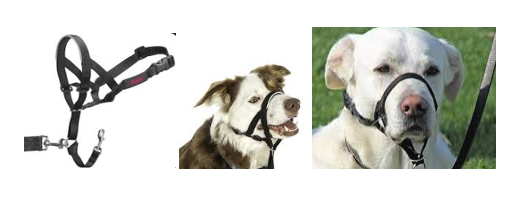
Harness (Body): Various harness options are available, including those the dog steps into or those that require manual leg manipulation. There are “no-pull” harnesses, H or Y-shaped varieties, specialty harnesses with Velcro for name tags, sled dog team harnesses, service dog harnesses, tactical harnesses, those designed to carry poop bags, and even doggie coats with built-in harnesses.
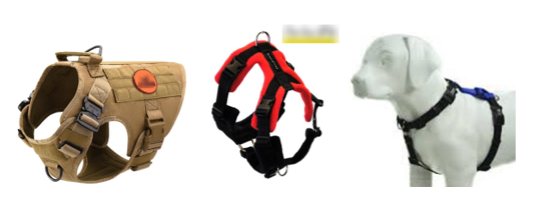
Leashes
Slip Lead: Slip Lead: A rope leash with a handle at one end and a movable loop at the other, which adjusts as the dog moves.
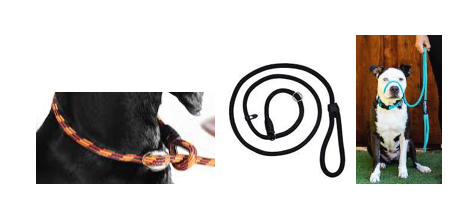
Leashes: There are numerous leash types, including leather, neoprene, biothane, rope, and retractable varieties. They differ in thickness, colors, patterns, and styles.
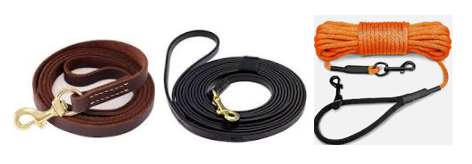
Why Do the Tools We Choose Matter?
The tools we select for our dogs should primarily serve safety and communication purposes, not control or correction. It’s vital to recognize that anything we put on our dogs can be considered aversive if it causes a “strong dislike or disinclination.” Therefore, we must assess the potential harm these tools may cause, both physically and emotionally.
For instance, any collar can cause damage. A flat collar exerts pressure, the Martingale tightens, and the prong collar introduces spikes that apply pressure and pain to the dog’s neck. Repeated or sustained pressure can result in irreparable neck damage, from chafing to cervical spine injuries. Critical structures like the larynx, trachea, and thyroid reside in the neck and throat area. As for face harnesses, a dog’s nose plays a pivotal role in their learning, and any pressure on it can limit them, even to a debilitating extent. Some trainers even suggest using a slip lead as a face harness to prevent pulling (as depicted above).
For most dogs, the least invasive tool is a harness paired with a long line. This combination keeps the dog tethered for safety while allowing freedom of movement and choice. It also provides clear communication to both ends of the leash. If your dog tends to pull during walks, please refer to our previous article titled “Why Do Dogs Pull on the Leash.” If you’re contemplating changing your tools but are uncertain about the options, please reach out to a choice, science-based, positive trainer in your area.
Article by Mariana Jones
Based in Waterloo, Ontario, Canada, Mariana Jones (MJ to all that know her) was the first Family Dog Mediator® in Ontario! One thing, that as an FDM® she is very passionate about, is bridging the gap between what our dogs need and what we, as their caregivers, want.
The goal for MJ and My Girl Friday (MGF) is to empower every dog and human to live together with understanding, kindness, compassion, empathy, trust and love. MJ helps humans to understand WHY a behaviour may be happening, based on the L.E.G.S® (Learning, Environment, Genetics and Self) of the dog. Once we know WHY the behaviour is happening, we can figure out HOW to help the dog and what we need to teach them so they can thrive in our human world.
MJ currently shares her life with her two children (Victor and Bella), three dogs (Happy, Joy and Maximum) and two cats (Monster and Magic). Every dog in her life teaches, inspires and brings joy to her every single day!
Website: My-girl-friday.ca
Facebook: My Girl Friday – Dog Training
Instagram: mjatmgf





